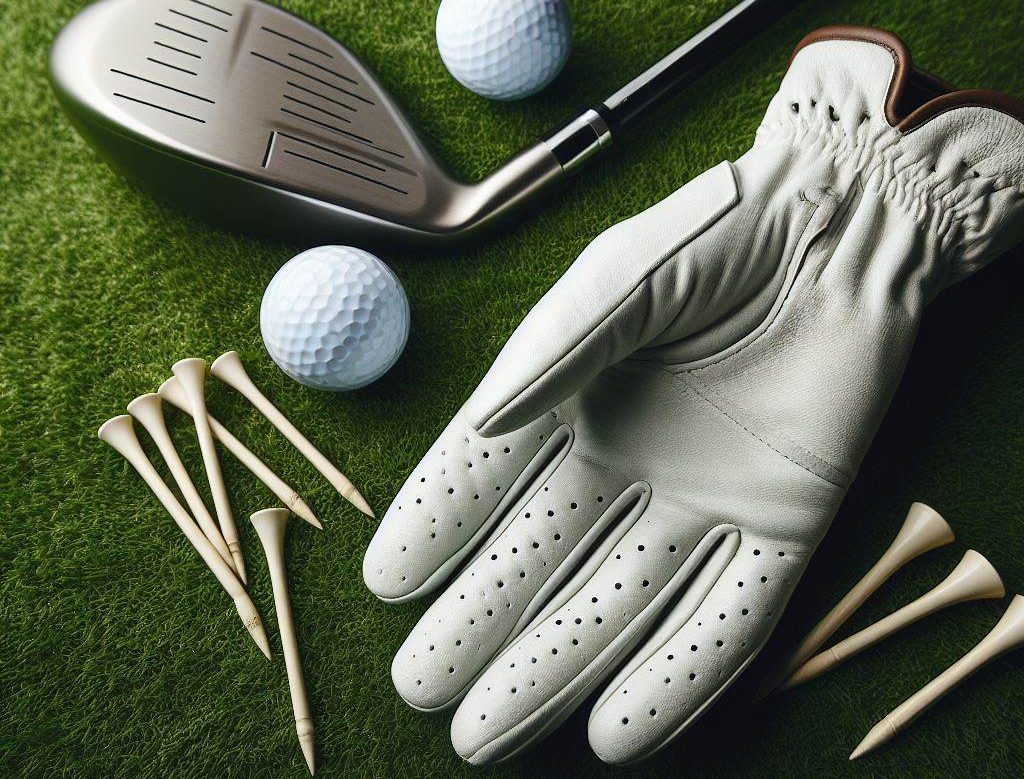One intriguing aspect that often captures curiosity is why most right-handed players wear their glove specifically on their left hand while playing golf? The answer lies in understanding how each hand contributes differently to a golfer’s swing mechanics. In essence, wearing a glove predominantly on one hand allows players to strike a balance between grip stability and hand sensitivity.
The left hand plays a vital role in the golf swing for right-handed players. It is responsible for establishing the initial grip position and maintaining control throughout the swing motion.
By wearing a glove on the left hand, golfers ensure optimal grip stability during impact with the ball, minimizing any chance of unexpected twisting or slipping that could affect shot accuracy. Additionally, as most of the force generated in a golf swing originates from the dominant (right) hand, focusing on enhancing grip sensitivity without a glove allows for greater feel and touch during crucial shot-making moments.
Golf gloves are an essential accessory for any serious golfer seeking to improve their game. They not only enhance grip stability but also provide protection from discomfort and enable greater control over shot execution.
The convention of wearing gloves on the left hand for right-handed players is rooted in optimizing grip performance while maintaining tactile sensitivity where it matters most. In subsequent sections, we will delve further into historical aspects, explore hand dominance research among golfers, and discuss additional benefits associated with wearing golf gloves.
Historical Background
Tracing the origins of golf gloves back to early Scottish golfers
Golf, as we know it today, has a long and storied history that dates back several centuries. Early forms of the game were played in Scotland during the 15th century, where it was primarily enjoyed by nobility and played on rough terrains. It was during this time that the use of gloves in golf began to emerge.
Scottish golfers soon realized that wearing gloves could provide them with a better grip on their clubs while swinging and improve their overall performance on the course. The first golf gloves were made from natural materials like leather or wool, meticulously crafted by skilled craftsmen.
These primitive gloves had a simple design, featuring full finger coverage and an open palm for maximum flexibility. They served as a protective layer between the golfer’s hands and the rough texture of early wooden club handles.
Exploring the evolution of glove materials and design
Throughout history, advancements in technology and manufacturing have led to significant improvements in glove materials and design. In the early 20th century, leather became the material of choice for golf gloves due to its durability and natural grip-enhancing properties.
Leather gloves offered players a snug fit, allowing for better control over their swings while providing necessary protection against blisters. As time went on, manufacturers began experimenting with new synthetic materials such as synthetic leathers, microfiber fabrics, and even high-performance polymers.
These advancements revolutionized golf glove design by offering enhanced breathability, moisture-wicking capabilities, improved grip properties even under adverse weather conditions. Modern-day golf gloves now come in various designs tailored to different playing styles and preferences.
Some feature perforated panels to enhance airflow during hot weather rounds; others incorporate silicon or textured patterns on specific areas for better traction during wet conditions. With continuous innovation driving design improvements, golfers today have access to an extensive range of gloves that cater to their specific needs.
The evolution of golf glove materials and design reflects the game’s progression over time. From humble beginnings as a simple accessory for improving grip, golf gloves have become technologically advanced tools that enhance performance while providing comfort and protection on the course.
The Importance of Grip in Golf
How Grip Affects Swing Performance and Shot Accuracy
A fundamental aspect of the game of golf lies in the grip, as it directly influences swing performance and shot accuracy. The grip serves as the connection between the golfer and the club, transmitting the force generated by the swing into a controlled strike on the ball. A proper grip provides stability, control, and consistency throughout the swing motion.
Without a secure grip, golfers may struggle to achieve optimal results with their shots. When analyzing how grip affects swing performance, it is essential to consider its impact on clubface alignment.
The position of the hands on the club determines how square or open/closed the face is at impact. An incorrect grip can lead to misalignment, resulting in errant shots that veer off target.
Conversely, a correct grip facilitates a square clubface at impact, promoting straighter shots with enhanced accuracy. Furthermore, an effective grip allows for better control over shot trajectory and spin.
By positioning their hands correctly on the club handle, golfers can manipulate these factors based on their desired outcome for each shot. For instance, gripping higher up on the handle tends to increase loft while decreasing distance traveled; conversely, gripping lower down promotes lower trajectory shots with more roll upon landing.
The Role of Hand Friction in Maintaining a Secure Grip
Hand friction plays a crucial role in maintaining a secure grip throughout all phases of a golfer’s swing. When striking the ball with speed and force during downswing and impact, there is an inherent tendency for hands to slip along with extended contact between hand and golf club handle. To overcome this challenge and ensure consistent contact between hand and club handle during swings, golf gloves come into play as vital aids.
Made from materials such as leather or synthetic fabrics designed specifically for enhancing traction between hand and grip, golf gloves provide an additional layer of grip and stability. The utilization of these gloves significantly reduces the likelihood of the club slipping from the golfer’s hands during crucial moments, allowing for a more controlled and confident swing.
Moreover, hand friction also helps golfers maintain a consistent grip pressure. A firm but not overly tense grip is essential for optimal swing mechanics and shot execution.
Too loose of a grip can lead to clubhead rotation, resulting in inconsistent strikes, while gripping too tightly may hinder fluidity in the swing motion. Golf gloves augment hand friction, enabling golfers to find that delicate balance in grip pressure required for optimal performance.
Understanding the importance of grip in golf is paramount for any golfer looking to improve their game. The way a golfer grips the club directly impacts swing performance and shot accuracy by influencing clubface alignment, trajectory control, and spin manipulation.
Additionally, hand friction facilitated by golf gloves plays a vital role in maintaining a secure grip throughout the swing motion. By recognizing these factors and employing proper techniques aided by high-quality gloves designed to optimize hand traction, golfers can enhance their overall game performance on the course.
Hand Dominance in Golfers
When it comes to hand dominance among golfers, various studies have shed light on the prevalence of right-handedness in the sport. It is estimated that approximately 90% of golfers are right-handed, which raises the question: why do these predominantly right-handed players wear gloves on their left hand?
The answer lies in the mechanics and intricacies of the golf swing. A golfer’s dominant hand, typically their right hand, plays a crucial role in controlling power and accuracy during the swing.
This is evident in how the dominant hand exerts most of the force while gripping and swinging the club. However, while grip strength is essential for generating power, it is equally important to maintain a consistent grip throughout the swing.
To ensure consistency and prevent slippage or loss of control during a swing, golfers wear gloves on their non-dominant hand – usually their left hand for right-handed players. This strategic decision allows golfers to maximize their grip strength with their dominant hand while leveraging the added traction provided by gloves on their non-dominant hand.
Examining studies on hand dominance among golfers
A number of studies have investigated patterns of hand dominance among golfers to support this notion further. These studies often involve analyzing grip pressure distribution and club control during swings.
The findings consistently demonstrate that players who wear gloves only on their non-dominant hands exhibit improved control over both low and high-pressure swings. In addition, these studies have revealed that wearing a glove can help minimize inconsistencies caused by variations in sweat production or moisture levels between hands.
By maintaining a steady grip across all shots, regardless of external factors like humidity or rain-induced perspiration, golfers can achieve greater precision in shot execution. Furthermore, researchers have observed that golfers who wear gloves on their non-dominant hand tend to experience fewer instances of grip-related injuries, such as calluses or blisters.
This is attributed to the protective layer provided by the glove, which reduces friction between the hand and the club grip. As a result, golfers can practice and play for longer periods without discomfort or potential disruptions in their swing mechanics.
Explaining why most golfers are right-handed but wear gloves on their left hand
The reason behind most right-handed golfers wearing gloves on their left hand is rooted in tradition and practicality.
Historically, golf gloves were designed to be worn on the weaker hand – the non-dominant hand for right-handers – to enhance grip strength and control during swings. This practice has been passed down through generations of golfers and has become deeply ingrained in the sport’s culture.
Besides tradition, wearing a glove on the non-dominant hand also makes practical sense for right-handed players. Since the dominant hand typically exerts more force during a swing, it is prone to sweat more profusely.
By wearing a glove on the non-dominant (left) hand instead, which often encounters less perspiration due to its lesser role in power generation, golfers can mitigate grip slippage caused by moisture accumulation. While most golfers are right-handed, they choose to wear gloves on their left hands due to the benefits it offers in terms of consistent grip pressure, enhanced control over swings, injury prevention, and adherence to established traditions.
The placement of gloves allows them to optimize power from their dominant hands while relying on added traction from their non-dominant hands. This combination ultimately contributes to improved performance and enjoyment of the game.
Protection and Comfort Factors
Golf is a sport that demands repetitive gripping and swinging motions, which can take a toll on the hands of players. Wearing a golf glove on the left hand provides essential protection and comfort during play.
One of the primary benefits of wearing a glove is the prevention of blisters and calluses that can develop from the friction between the club grip and bare skin. The soft, leather or synthetic material used in golf gloves acts as a barrier, reducing rubbing and minimizing the formation of painful blisters.
In addition to blister prevention, gloves also offer cushioning for impact absorption. As golfers repeatedly strike the ball with considerable force, particularly during drives or shots from challenging lies, shockwaves can reverberate through their hands.
The padding in golf gloves helps to absorb some of this impact, reducing discomfort and potential hand injuries such as strains or sprains. Furthermore, golf gloves prove highly beneficial in protecting against extreme weather conditions that players often encounter on the course.
In scorching summer heat where perspiration is inevitable, gloves help maintain a secure grip by absorbing sweat from palms and fingers. This feature ensures that clubs do not slip out of hands due to excessive moisture accumulation.
Discussing how gloves protect against extreme weather conditions, such as heat or rain
Golfers often face adverse weather while playing their rounds – be it strong sunrays or unexpected rain showers – where specialized gear becomes crucial for optimal performance. When it comes to dealing with hot weather conditions, golf gloves play a vital role in ensuring both grip stability and comfort. The breathable materials used in manufacturing quality golf gloves allow air circulation around the hand while protecting against harmful UV rays.
This ventilation helps minimize excessive sweating by allowing moisture to evaporate more efficiently than with bare skin alone. Consequently, maintaining dry palms prevents the accumulation of sweat, reduces discomfort, and maintains a consistent grip throughout the round.
Moreover, gloves also prove invaluable during rainy rounds. The wet conditions can make club grips slippery and compromise a golfer’s ability to maintain control over their shots.
However, by wearing a glove on the left hand, players can still maintain a reliable grip even when their clubs or hands become damp. The textured patterns present on most golf gloves’ palms provide enhanced friction and traction between the hand and the club grip, ensuring better control even in adverse weather conditions.
Enhanced Feel and Control
Unleashing the Power of Touch for Precision
When it comes to golf, the connection between a golfer’s hand and the club grip is crucial for executing precise shots. This is where golf gloves play a vital role in enhancing feel and control.
By wearing a glove on the left hand, which is in direct contact with the club, golfers experience improved tactile feedback. The texture and material of golf gloves provide a grippy surface that allows players to better sense the nuances of their grip, enabling them to make subtle adjustments during their swing.
This heightened connection between hand and club empowers golfers with greater control over their shots. The impact of improved feel on shot execution cannot be overstated.
Golfers rely heavily on muscle memory and proprioception to consistently repeat successful swings. A well-fitted glove not only enhances grip but also aids in developing muscle memory for consistent grip placement.
When every touchpoint between hand and club feels familiar, it becomes easier for golfers to maintain proper technique throughout their swings. The finer touch sensitivity facilitated by golf gloves enables players to detect even the slightest deviations from their ideal grip configuration, allowing them to make real-time corrections for better shot execution.
Consistency in Swing Mechanics
Promoting Fluidity through Grip Stability
Analyzing how wearing a glove promotes consistent grip pressure throughout swings reveals an essential aspect of maintaining optimal swing mechanics in golf. As golfers progress through various phases of their swing – from backswing to downswing – maintaining stable grip pressure is crucial for generating power and achieving accurate ball-striking consistency. A well-fitted glove provides an extra layer of friction between hand and club, ensuring that the grip remains secure throughout each movement.
Consistency also stems from muscle memory development with consistent grip placement. By wearing a glove on the left hand, right-handed golfers establish a consistent reference point for their grip.
This repetitive muscle memory aids in developing a consistent swing path and clubface angle, which ultimately leads to improved shot accuracy. Over time, the act of wearing a glove on the left hand becomes synonymous with adopting a repeatable grip, enhancing the efficiency and fluidity of swing mechanics.
Etiquette and Tradition
A Stalwart Symbol of Golfing Customs
Investigating traditional norms that dictate wearing a glove on the left hand unravels profound etiquette intertwined with golfing traditions. Wearing a glove on the left hand is deeply ingrained in the sport’s culture, symbolizing respect for both history and decorum.
Following this tradition helps maintain consistency among players and promotes an atmosphere of unity during tournaments. Moreover, discussing etiquette guidelines for proper glove usage during tournaments emphasizes the importance of adhering to established customs.
Tournaments hold golfers to high standards of conduct, with rules that dictate when gloves should be worn or removed. By familiarizing themselves with these guidelines, players demonstrate their commitment to honoring the traditions of the game while showcasing their professionalism on the course.
Considerations
Exploring Exceptions to Reinforce Individuality
While it is customary for right-handed players to wear gloves on their left hand, there are instances where exceptions arise—instances where right-handed players wear gloves on their right hand instead. Although relatively uncommon, some individuals find better comfort or enhanced feel when wearing a glove on their dominant hand.
These niche considerations highlight that despite prevailing practices in golf attire and equipment usage, individual preferences can still play a role in determining what feels most natural and effective for each golfer’s unique playing style. Conclusion:
It becomes evident why golfers don gloves primarily on their left hands through an exploration of enhanced feel and control, consistency in swing mechanics, adherence to etiquette and tradition, and niche considerations. Golf gloves not only enhance tactile feedback between hand and club for improved shot execution but also promote stability and muscle memory development.
They serve as a symbol of respect for golfing traditions while accommodating individual preferences. By embracing the significance of golf gloves on the left hand, players find themselves equipped with not just physical advantages but also an appreciation for the heritage that enriches their golfing experience.





